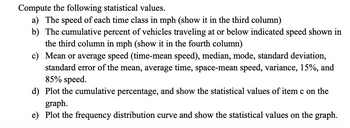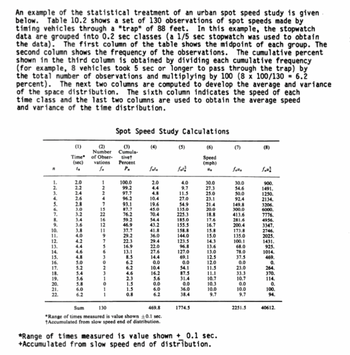
MATLAB: An Introduction with Applications
6th Edition
ISBN: 9781119256830
Author: Amos Gilat
Publisher: John Wiley & Sons Inc
expand_more
expand_more
format_list_bulleted
Question

Transcribed Image Text:Compute the following statistical values.
a) The speed of each time class in mph (show it in the third column)
b) The cumulative percent of vehicles traveling at or below indicated speed shown in
the third column in mph (show it in the fourth column)
c) Mean or average speed (time-mean speed), median, mode, standard deviation,
standard error of the mean, average time, space-mean speed, variance, 15%, and
85% speed.
d) Plot the cumulative percentage, and show the statistical values of item c on the
graph.
e) Plot the frequency distribution curve and show the statistical values on the graph.

Transcribed Image Text:An example of the statistical treatment of an urban spot speed study is given
below. Table 10.2 shows a set of 130 observations of spot speeds made by
timing vehicles through a "trap" of 88 feet. In this example, the stopwatch
data are grouped into 0.2 sec classes (a 1/5 sec stopwatch was used to obtain
the data). The first column of the table shows the midpoint of each group. The
second column shows the frequency of the observations. The cumulative percent
shown in the third column is obtained by dividing each cumulative frequency
(for example, 8 vehicles took 5 sec or longer to pass through the trap) by
the total number of observations and multiplying by 100 (8 x 100/130 = 6.2
percent). The next two columns are computed to develop the average and variance
of the space distribution. The sixth column indicates the speed of each
time class and the last two columns are used to obtain the average speed
and variance of the time distribution.
Spot Speed Study Calculations
(1)
(2)
Number
Time*
(sec)
of Obser-
(3)
Cumula-
tivet
(4)
(5)
(6)
(7)
(8)
Speed
vations
Percent
(mph)
"
P
fr
Salla
S.
1
100.0
2.0
4.0
30.0
30.0
900.
2
99.2
4.4
9.7
27.3
54.6
1491.
97.7
4.8
11.5
25.0
50.0
1250.
96.2
10.4
27.0
23.1
25.1
92.4
2134.
93.1
19.6
$4.9
21.4
149.8
3206.
87.7
45.0
135.0
20.0
300.0
6000.
6000.
76.2
70.4
225.3
18.8
413.6
7776.
7776.
59.2
54.4
185.0
17.6
281.6
4956.
4936.
46.9
43.2
155.5
16.7
10.
3.8
37.7
200.4
3347.
41.8
158.8
15.8
173.8
2746.
11.
4.0
29.2
36.0
144.0
15.0
135.0
2025.
12.
4.2
22.3
29.4
123.5
14.3
100.1
1431.
13.
4.4
16.9
22.0
96.8
13.6
68.0
925.
14.
4.6
13.1
27.6
127.0
13.0
15.
4.8
8.5
14.4
69.1
78.0
1014.
12.5
37.5
469.
16.
5.0
6.2
0.0
0.0
12.0
0.0
0.
17.
5.2
6.2
10.4
54.1
11.5
23.0
264.
18.
5.4
4.6
16.2
87.5
11.1
33.3
370.
19.
5.6
1
2.3
5.6
31.4
10.7
10.7
114.
20.
5.8
0
1.5
0.0
0.0
10.3
0.0
0.
21.
6.0
1
1.5
6.0
36.0
10.0
10.0
100.
22.
6.2
1
0.8
6.2
38.4
9.7
9.7
94.
Sum
130
469.8
1774.5
2251.5
40612.
*Range of times measured is value shown ±0.1 sec.
+Accumulated from slow speed end of distribution.
*Range of times measured is value shown + 0.1 sec.
+Accumulated from slow speed end of distribution.
Expert Solution
This question has been solved!
Explore an expertly crafted, step-by-step solution for a thorough understanding of key concepts.
This is a popular solution
Trending nowThis is a popular solution!
Step by stepSolved in 4 steps with 2 images

Knowledge Booster
Similar questions
- Calculate mean deviation from mean and median for the following data: 100, 150, 200, 250, 360, 490, 500, 600, 671 also calculate coefficients of M.D?arrow_forwardyears (Round to two decimal places as needed.) years (Round to two decimal places as needed.)arrow_forwardCompute the mean, standard deviation and the coefficient of the variation of the data 10, 13, 15, 12, 18, 17arrow_forward
- Represent the Data Set X= {6,5,9,7,7,8, 5, 10,8, 6, 8, 8, 4, 7,8, 7,6} with a bar chart and determine; a) Its mode and its range. b) Its median, upper & lower quartiles and inter-quartile range. c) Its mean, variance and standard deviation.arrow_forwardSolve for C)arrow_forwardFind the mean absolute deviation of the data below 10,15,9,8,7,11,14,8,10,12arrow_forward
- The table below gives the weight measurements of 200 castings: Weight in Kg. No. of Castings Weight in Kg. No. of Castings 81-90 2 141-150 37 91-100 5 151-160 29 101-110 13 161-170 11 111-120 20 171-180 3 121-130 30 181-190 131-140 49 Calculate arithmetic mean, median, mode and standard deviation.arrow_forwardcalculate the standard deviation of the data shown, 27.7, 10.8, 10.6, 21.1,22.1. round to 2 decimal placesarrow_forwardIf data set A has a larger standard deviation than data set B, data set A is more spread out than data set B. A. True B. Falsearrow_forward
- the driving distances (miles) to wor of 30 people are shown below. assume the population standard deviation is 8 miles. Find: 12, 9, 7, 3, 27, 21, 2, 30, 7, 4, 1, 10, 2, 9, 2, 28, 7, 10, 13, 6, 13, 7, 3, 13, 6, 6, 3, 13 ,12, 16, 18 a) the point estimate of the population mean b) the margin of error for a 95% confidence interval c) contruct a 95% confidence interval for the population mean.arrow_forwardIdentify the statistic that is used to estimate a. a population mean.b. a population standard deviation.arrow_forwardthe "age" variable measures participants age in years. use spss to calculate the mean age of the sample. the mean age of students in this data set is ____years. enter your answer rounded to two decimal places.arrow_forward
arrow_back_ios
SEE MORE QUESTIONS
arrow_forward_ios
Recommended textbooks for you
 MATLAB: An Introduction with ApplicationsStatisticsISBN:9781119256830Author:Amos GilatPublisher:John Wiley & Sons Inc
MATLAB: An Introduction with ApplicationsStatisticsISBN:9781119256830Author:Amos GilatPublisher:John Wiley & Sons Inc Probability and Statistics for Engineering and th...StatisticsISBN:9781305251809Author:Jay L. DevorePublisher:Cengage Learning
Probability and Statistics for Engineering and th...StatisticsISBN:9781305251809Author:Jay L. DevorePublisher:Cengage Learning Statistics for The Behavioral Sciences (MindTap C...StatisticsISBN:9781305504912Author:Frederick J Gravetter, Larry B. WallnauPublisher:Cengage Learning
Statistics for The Behavioral Sciences (MindTap C...StatisticsISBN:9781305504912Author:Frederick J Gravetter, Larry B. WallnauPublisher:Cengage Learning Elementary Statistics: Picturing the World (7th E...StatisticsISBN:9780134683416Author:Ron Larson, Betsy FarberPublisher:PEARSON
Elementary Statistics: Picturing the World (7th E...StatisticsISBN:9780134683416Author:Ron Larson, Betsy FarberPublisher:PEARSON The Basic Practice of StatisticsStatisticsISBN:9781319042578Author:David S. Moore, William I. Notz, Michael A. FlignerPublisher:W. H. Freeman
The Basic Practice of StatisticsStatisticsISBN:9781319042578Author:David S. Moore, William I. Notz, Michael A. FlignerPublisher:W. H. Freeman Introduction to the Practice of StatisticsStatisticsISBN:9781319013387Author:David S. Moore, George P. McCabe, Bruce A. CraigPublisher:W. H. Freeman
Introduction to the Practice of StatisticsStatisticsISBN:9781319013387Author:David S. Moore, George P. McCabe, Bruce A. CraigPublisher:W. H. Freeman

MATLAB: An Introduction with Applications
Statistics
ISBN:9781119256830
Author:Amos Gilat
Publisher:John Wiley & Sons Inc

Probability and Statistics for Engineering and th...
Statistics
ISBN:9781305251809
Author:Jay L. Devore
Publisher:Cengage Learning

Statistics for The Behavioral Sciences (MindTap C...
Statistics
ISBN:9781305504912
Author:Frederick J Gravetter, Larry B. Wallnau
Publisher:Cengage Learning

Elementary Statistics: Picturing the World (7th E...
Statistics
ISBN:9780134683416
Author:Ron Larson, Betsy Farber
Publisher:PEARSON

The Basic Practice of Statistics
Statistics
ISBN:9781319042578
Author:David S. Moore, William I. Notz, Michael A. Fligner
Publisher:W. H. Freeman

Introduction to the Practice of Statistics
Statistics
ISBN:9781319013387
Author:David S. Moore, George P. McCabe, Bruce A. Craig
Publisher:W. H. Freeman